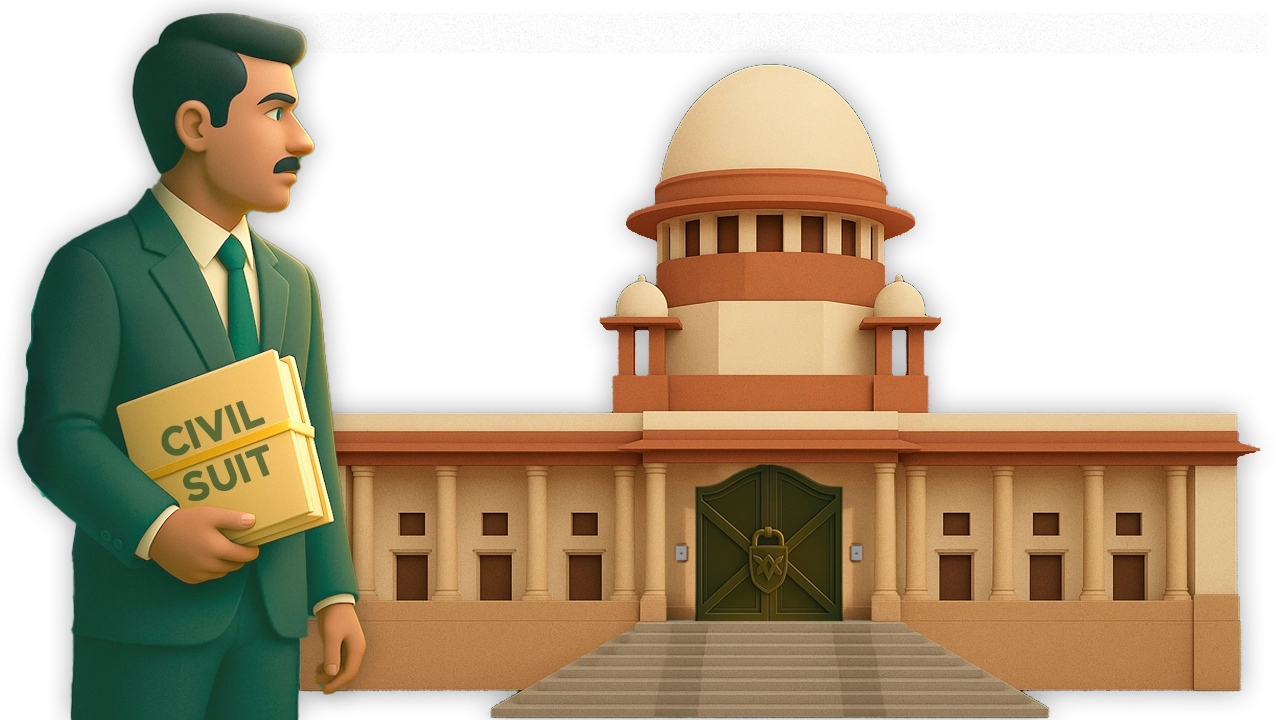Introduction
In the high-stakes world of commercial disputes, an arbitral award is often seen as the final word. However, for a losing party, it can feel more like a setback to be overcome than a conclusion to be accepted. It’s a common maneuver in India’s legal landscape for a company on the wrong side of a decision to seek an alternative battlefield. Instead of accepting the arbitrator’s verdict, they might launch a new offensive by filing a civil suit, hoping to find a sympathetic ear in a regular court. This tactic is a strategic attempt to circumvent the finality of the award, essentially asking a judge to undo what the arbitrator has done—a move that often puts the entire arbitration process on trial once again.
However, in a significant ruling in MMTC Limited vs. Anglo-American Metallurgical Pty Limited and Ors1., the Delhi High Court, through the bench of Justice Jasmeet Singh, has clarified that this practice is legally impermissible. The court held that an arbitral award cannot be challenged by way of a civil suit, as this course of action is expressly barred under Section 5 read with Section 34 of the Arbitration Act2. The judgment further stated that such a lawsuit must be rejected under Order VII Rule 11(d) of the CPC3 on the grounds that it is barred by law.
This legal battle began with a fascinating contention. The plaintiff, having already invoked criminal remedies by filing a complaint with the CBI, also sought to independently challenge the arbitral award through a civil suit. The plaintiff argued that such a suit was maintainable, especially since the award, according to them, was obtained through fraud discovered only after the arbitration proceedings had concluded. They contended that since the Arbitration Act does not provide a remedy for such a post-arbitration discovery of fraud, they should not be left without recourse. The defendants, on the other hand, vehemently opposed this, arguing that the true essence of the suit was to nullify an international award that had already attained finality, even up to the Supreme Court. They submitted that such a recourse was barred by law under Sections 5 and 34 of the Arbitration Act, and that allowing such a suit would undermine the sanctity of arbitral awards and defeat the very purpose of the Act.
This legal conundrum, which pitted the finality of arbitration against the pursuit of justice for alleged fraud, posed a fundamental question to the court: could a civil suit serve as a backdoor to nullify an award that had already run its course? To understand the court’s decisive answer, this article will now delve into a thorough analysis of the judicial precedent, dissecting the key provisions and legal principles that formed the very foundation of its ruling.
The Finality of Arbitration: Why Civil Suits Against Arbitral Awards Fail
In the world of dispute resolution, the choice to arbitrate is a pact of faith between parties—a faith in a system designed for speed, expertise, and, most importantly, finality. But what happens when that faith is broken, and a disgruntled party attempts to re-litigate a matter through a civil suit? The law, as it stands, offers a clear and definitive answer. This article delves into the legal provisions and landmark cases that firmly establish why a civil suit cannot be maintained to challenge an arbitral award.
The central thesis of Indian arbitration law is enshrined in a principle of minimal judicial intervention. This isn’t a mere suggestion but a legislative mandate, woven into the very fabric of the Arbitration Act. The journey to understanding this begins with a few key provisions and the judicial interpretations that have shaped their meaning.
Section 5 of the 1996 Act: The Non-Obstante Barrier
At the heart of this discussion is Section 5 of the Arbitration Act, a provision that begins with a “non obstante” clause. This powerful legal tool means “notwithstanding anything contained in any other law for the time being in force,” effectively giving the Arbitration Act an overriding effect. The Supreme Court, in Interplay (supra), meticulously dissected this provision. The court emphasized that the legislative intent behind Section 5 is to “minimise the supervisory role of Courts in the arbitral process” and to give effect to the “true intention of the parties to have their disputes resolved through arbitration in a quick, efficient and effective manner.” This means that unless the 1996 Act itself provides a window for judicial intervention, no court can step in. As the court further noted, the use of a non obstante clause is to “remove all obstructions which might arise out of the provisions of any other law.”
So, where is this window of intervention? The Arbitration Act, being a self-contained code, provides a complete framework for challenging an award, and that window is Section 34.
Section 34: The Exhaustive and Exclusive Remedy
Section 34 of the 1996 Act lays out the “only” recourse to a court against an arbitral award. It explicitly states that an award may be set aside “only” by an application for that purpose and “only” on the grounds specified within the section. The repetition of the word “only” is not a stylistic choice; it is a clear legislative command. As a result, no challenge to an arbitral award can be launched outside of this section or beyond the grounds it specifies. This is a critical point that leaves no room for ambiguity.
The plaintiff in the case at hand, relying on cases like Central Bank of India4 , argued that even if some prayers were barred, the plaint could not be rejected in piecemeal. However, the court found that all reliefs, including those for declaration and recovery, were intrinsically “linked to the nullification of the Arbitral Award.” Without first setting aside the award, which the court was barred from doing, no independent relief could be granted.
The Fraud Exception: Not a Get-Out-of-Jail-Free Card
A common argument raised by plaintiffs is that an award obtained by fraud should be challengeable through a civil suit. This contention, however, has been consistently addressed by the judiciary. The plaintiff here relied on cases like National Projects Construction Corporation5 (supra) and M. Hariharasudhan6 (supra) to support this argument. However, the court correctly distinguished them. The court observed that the National Projects Construction Corporation(supra) judgment was prior to the landmark Interplay7 (supra) ruling, which provided a more definitive explanation of the scope of Section 5. Similarly, the reliance on M. Hariharasudhan (supra) was deemed “misconceived” given the express bar created by Sections 5 and 34.
Furthermore, the court drew a crucial distinction between fraud “upon the Arbitral Tribunal” and fraud “inter se among the parties.” The plaintiff’s core contention was that the “Addendum No. 2” was vitiated by fraud among its own officers and the defendants, not that the award was obtained by defrauding the tribunal itself. The court also pointed out that even if this were the case, Section 34 already includes “award induced or affected by fraud or corruption” as a ground for challenge, which the plaintiff failed to raise timely.
The jurisprudence on fraud has evolved, as seen in cases like Rashid Raza v. Sadaf Akhtar8 (supra) and Amrish Gupta v. Gurchait Singh Chima9 (supra). The Supreme Court in Rashid Raza (supra) laid down “two working tests,” making a distinction between fraud that “permeate[s] the entire contract” and simple allegations. A co-ordinate bench in Amrish Gupta (supra) held that allegations of fraud “do not fall in either of the two categories” of non-arbitrable disputes and, if a civil court can decide a matter in a trial, so can an arbitral tribunal. Therefore, since the original LTA containing the arbitration clause was not in dispute, the plea of fraud regarding the addendum was considered “arbitrable in nature.”
The Bar of CPC: A Final Nail in the Coffin
The final piece of the puzzle lies in the CPC itself. Section 9 of the CPC grants courts jurisdiction to try all suits “unless barred.” Section 5, read with Section 34 of the Arbitration Act, constitutes this express and implied bar. The court, citing Interplay (supra) again, noted that by choosing arbitration, parties “surrender their right to litigate before the national courts.”
Allowing civil suits to challenge arbitral awards, particularly those already upheld by the Supreme Court, would not only be a “travesty of justice” but would also “render the 1996 Act nugatory” and “undermine public confidence in Arbitration.” The court, in its conclusion, rightly rejected the plaint under Order VII Rule 11 of the CPC, which mandates the rejection of a plaint where the suit is “barred by law.”
In essence, the judicial pronouncements in Interplay (supra), Rashid Raza (supra), and Amrish Gupta (supra) have created a robust legal framework that upholds the finality of arbitration. The remedies provided within the Arbitration Act are not merely suggestions; they are the “only” avenues available. Any attempt to circumvent this framework through a civil suit, even with allegations of fraud, is destined to be rejected, preserving the sanctity of the arbitral process and the precious time of the judiciary.
Conclusion
The judgement stands as a powerful and unambiguous affirmation of the principles governing arbitration in India. The judgment draws a clear line in the sand, unequivocally rejecting the notion that a civil suit can be used as a strategic backdoor to nullify an arbitral award. By rigorously applying the “non obstante” clause of Section 5 and the exhaustive nature of Section 34 of the Arbitration Act, the court has effectively sealed this avenue of challenge. The decision not only upholds the sanctity of the arbitration process but also safeguards its core objectives of finality, efficiency, and minimal judicial interference. It sends a strong message to litigants that having chosen arbitration, they must exhaust the remedies provided within that framework and not seek to restart the dispute in a new forum.
This judgment’s ramifications extend far beyond the immediate parties. It reinforces the legal certainty that arbitral awards, once affirmed by the courts, are not susceptible to collateral attacks through fresh litigation. This enhanced finality is a crucial incentive for businesses and investors to continue opting for arbitration, knowing that the process will not devolve into a never-ending cycle of challenges. By aligning with the pro-arbitration stance of the Supreme Court in cases like Interplay (supra), the High Court has solidified the foundation of India’s arbitration jurisprudence, ensuring that the country remains an attractive and reliable hub for commercial dispute resolution.
However, as the legal landscape evolves, a fascinating question might be raised in the future. While the court has decisively handled the issue of post-award fraud discovered after the Section 34 window has closed, what if a party discovers new and compelling evidence of fraud that, for genuine and justifiable reasons, could not have been presented within the statutory time limits? Will the courts, in such an extraordinary circumstance, ever find an inherent power or a novel interpretation of the law to prevent a grave miscarriage of justice, or will the finality of the award remain an absolute and unbreachable wall? This will be a key question for the next chapter of India’s arbitration story.
Citations
- MMTC Limited vs. Anglo-American Metallurgical Pty Limited and Ors.CS(COMM) 959 of 2024
- Arbitration and Conciliation Act, 1996
- Civil Procedure Code, 1908
- Central Bank of India vs. Smt. Prabha Jain and Others, (2025) 4 SCC 3
- National Projects Construction Corporation v. Royal Construction Co. Pvt. Ltd., 2017 SCC OnLine Del 10944
- M. Hariharasudhan v. R. Karmegam, (2019) 10 SCC 94
- Interplay Between Arbitration Agreements under Arbitration, 1996 & Stamp Act, 1899, In re, (2024) 6 SCC 1
- Rashid Raza v. Sadaf Akhtar, (2019) 8 SCC 710
- Amrish Gupta v. Gurchait Singh Chima, 2022 SCC OnLine Del 1116
Expositor(s): Adv. Anuja Pandit






